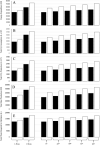Effects of body size and countermeasure exercise on estimates of life support resources during all-female crewed exploration missions
- PMID: 37045858
- PMCID: PMC10097614
- DOI: 10.1038/s41598-023-31713-6
Effects of body size and countermeasure exercise on estimates of life support resources during all-female crewed exploration missions
Abstract
Employing a methodology reported in a recent theoretical study on male astronauts, this study estimated the effects of body size and aerobic countermeasure (CM) exercise in a four-person, all-female crew composed of individuals drawn from a stature range (1.50- to 1.90-m) representative of current space agency requirements (which exist for stature, but not for body mass) upon total energy expenditure (TEE), oxygen (O2) consumption, carbon dioxide (CO2) and metabolic heat (Hprod) production, and water requirements for hydration, during space exploration missions. Assuming geometric similarity across the stature range, estimates were derived using available female astronaut data (mean age: 40-years; BMI: 22.7-kg·m-2; resting VO2 and VO2max: 3.3- and 40.5-mL·kg-1·min-1) on 30- and 1080-day missions, without and with, ISS-like countermeasure exercise (modelled as 2 × 30-min aerobic exercise at 75% VO2max, 6-day·week-1). Where spaceflight-specific data/equations were not available, terrestrial equivalents were used. Body size alone increased 24-h TEE (+ 30%), O2 consumption (+ 60%), CO2 (+ 60%) and Hprod (+ 60%) production, and water requirements (+ 17%). With CM exercise, the increases were + 25-31%, + 29%, + 32%, + 38% and + 17-25% across the stature range. Compared to the previous study of theoretical male astronauts, the effect of body size on TEE was markedly less in females, and, at equivalent statures, all parameter estimates were lower for females, with relative differences ranging from -5% to -29%. When compared at the 50th percentile for stature for US females and males, these differences increased to - 11% to - 41% and translated to larger reductions in TEE, O2 and water requirements, and less CO2 and Hprod during 1080-day missions using CM exercise. Differences between female and male theoretical astronauts result from lower resting and exercising O2 requirements (based on available astronaut data) of female astronauts, who are lighter than male astronauts at equivalent statures and have lower relative VO2max values. These data, combined with the current move towards smaller diameter space habitat modules, point to a number of potential advantages of all-female crews during future human space exploration missions.
© 2023. The Author(s).
Conflict of interest statement
J.P.R.S. is employed by Institut Médecine Physiologie Spatiale (MEDES); D.A.G. is employed by KBR, Cologne, Germany; G.W. is employed by the European Space Agency; S.N.C. owns and operates Sports Science Synergy, LLC. No specific funding was acquired for the article.
Figures

Similar articles
-
Body size and its implications upon resource utilization during human space exploration missions.Sci Rep. 2020 Aug 14;10(1):13836. doi: 10.1038/s41598-020-70054-6. Sci Rep. 2020. PMID: 32796944 Free PMC article.
-
Prevalence of sleep deficiency and use of hypnotic drugs in astronauts before, during, and after spaceflight: an observational study.Lancet Neurol. 2014 Sep;13(9):904-12. doi: 10.1016/S1474-4422(14)70122-X. Epub 2014 Aug 7. Lancet Neurol. 2014. PMID: 25127232 Free PMC article.
-
Effect of Exercise on Energy Expenditure and Body Composition in Astronauts Onboard the International Space Station: Considerations for Interplanetary Travel.Sports Med. 2022 Dec;52(12):3039-3053. doi: 10.1007/s40279-022-01728-6. Epub 2022 Jul 13. Sports Med. 2022. PMID: 35829995
-
The Astronaut-Athlete: Optimizing Human Performance in Space.J Strength Cond Res. 2015 Dec;29(12):3531-45. doi: 10.1519/JSC.0000000000001191. J Strength Cond Res. 2015. PMID: 26595138 Review.
-
Recent developments in space food for exploration missions: A review.Life Sci Space Res (Amst). 2023 Feb;36:123-134. doi: 10.1016/j.lssr.2022.09.007. Epub 2022 Sep 24. Life Sci Space Res (Amst). 2023. PMID: 36682821 Review.
References
-
- National Aeronautics and Space and Administration. Artemis. National Aeronautics and Space and Administration. https://www.nasa.gov/specials/artemis/ (2022a).
MeSH terms
Substances
LinkOut - more resources
Full Text Sources
Miscellaneous

